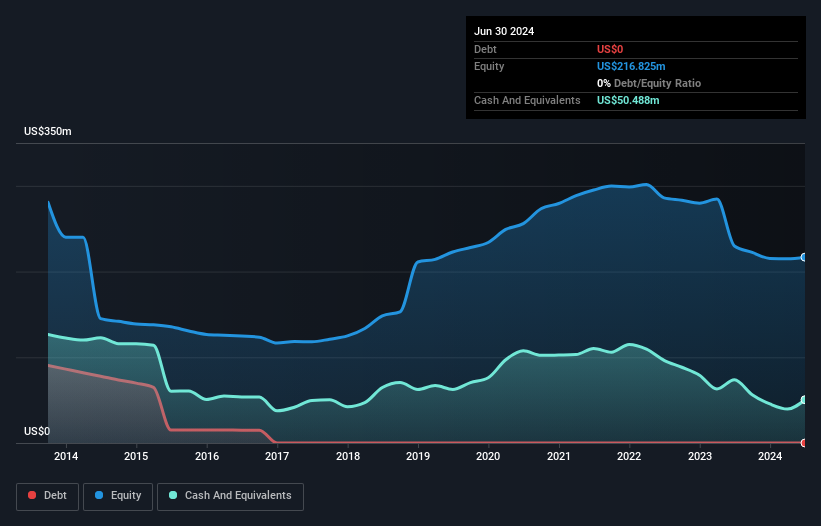There’s no doubt that money can be made by owning shares of unprofitable businesses. For example, although Amazon.com made losses for many years after listing, if you had bought and held the shares since 1999, you would have made a fortune. But while history lauds those rare successes, those that fail are often forgotten; who remembers Pets.com?
Given this risk, we thought we’d take a look at whether QuinStreet (NASDAQ:QNST) shareholders should be worried about its cash burn. For the purposes of this article, cash burn is the annual rate at which an unprofitable company spends cash to fund its growth; its negative free cash flow. Let’s start with an examination of the business’ cash, relative to its cash burn.
See our latest analysis for QuinStreet
Does QuinStreet Have A Long Cash Runway?
You can calculate a company’s cash runway by dividing the amount of cash it has by the rate at which it is spending that cash. In June 2024, QuinStreet had US$50m in cash, and was debt-free. In the last year, its cash burn was US$4.7m. So it had a very long cash runway of many years from June 2024. Depicted below, you can see how its cash holdings have changed over time.

How Well Is QuinStreet Growing?
Some investors might find it troubling that QuinStreet is actually increasing its cash burn, which is up 48% in the last year. At least the revenue was up 5.7% during the period, even if it wasn’t up by much. Considering both these factors, we’re not particularly excited by its growth profile. While the past is always worth studying, it is the future that matters most of all. So you might want to take a peek at how much the company is expected to grow in the next few years.
How Easily Can QuinStreet Raise Cash?
While QuinStreet seems to be in a fairly good position, it’s still worth considering how easily it could raise more cash, even just to fuel faster growth. Companies can raise capital through either debt or equity. Commonly, a business will sell new shares in itself to raise cash and drive growth. We can compare a company’s cash burn to its market capitalisation to get a sense for how many new shares a company would have to issue to fund one year’s operations.
Since it has a market capitalisation of US$1.0b, QuinStreet’s US$4.7m in cash burn equates to about 0.5% of its market value. So it could almost certainly just borrow a little to fund another year’s growth, or else easily raise the cash by issuing a few shares.
So, Should We Worry About QuinStreet’s Cash Burn?
It may already be apparent to you that we’re relatively comfortable with the way QuinStreet is burning through its cash. For example, we think its cash runway suggests that the company is on a good path. Although its increasing cash burn does give us reason for pause, the other metrics we discussed in this article form a positive picture overall. After taking into account the various metrics mentioned in this report, we’re pretty comfortable with how the company is spending its cash, as it seems on track to meet its needs over the medium term. An in-depth examination of risks revealed 1 warning sign for QuinStreet that readers should think about before committing capital to this stock.
If you would prefer to check out another company with better fundamentals, then do not miss this free list of interesting companies, that have HIGH return on equity and low debt or this list of stocks which are all forecast to grow.
Valuation is complex, but we’re here to simplify it.
Discover if QuinStreet might be undervalued or overvalued with our detailed analysis, featuring fair value estimates, potential risks, dividends, insider trades, and its financial condition.
Have feedback on this article? Concerned about the content? Get in touch with us directly. Alternatively, email editorial-team (at) simplywallst.com.
This article by Simply Wall St is general in nature. We provide commentary based on historical data and analyst forecasts only using an unbiased methodology and our articles are not intended to be financial advice. It does not constitute a recommendation to buy or sell any stock, and does not take account of your objectives, or your financial situation. We aim to bring you long-term focused analysis driven by fundamental data. Note that our analysis may not factor in the latest price-sensitive company announcements or qualitative material. Simply Wall St has no position in any stocks mentioned.







